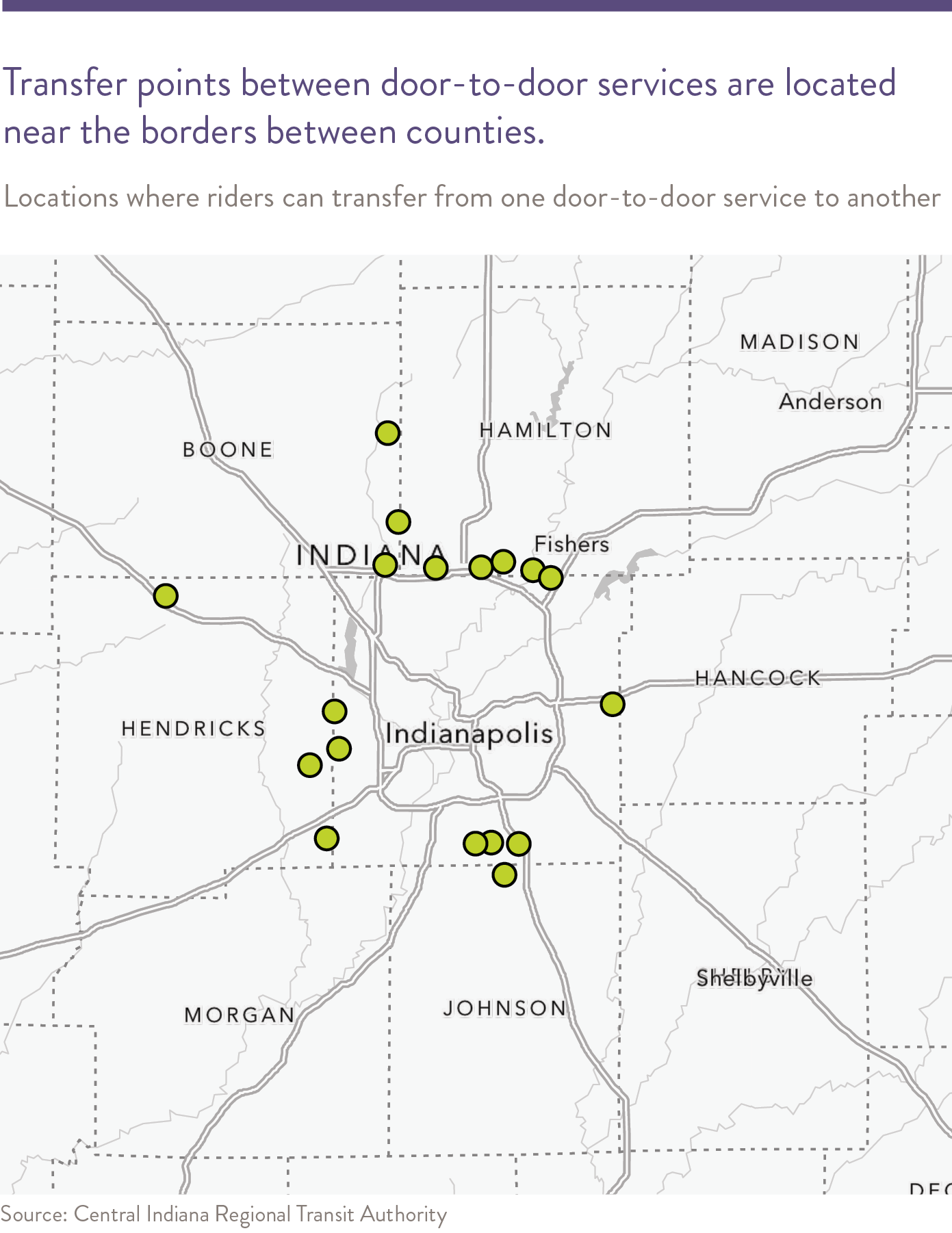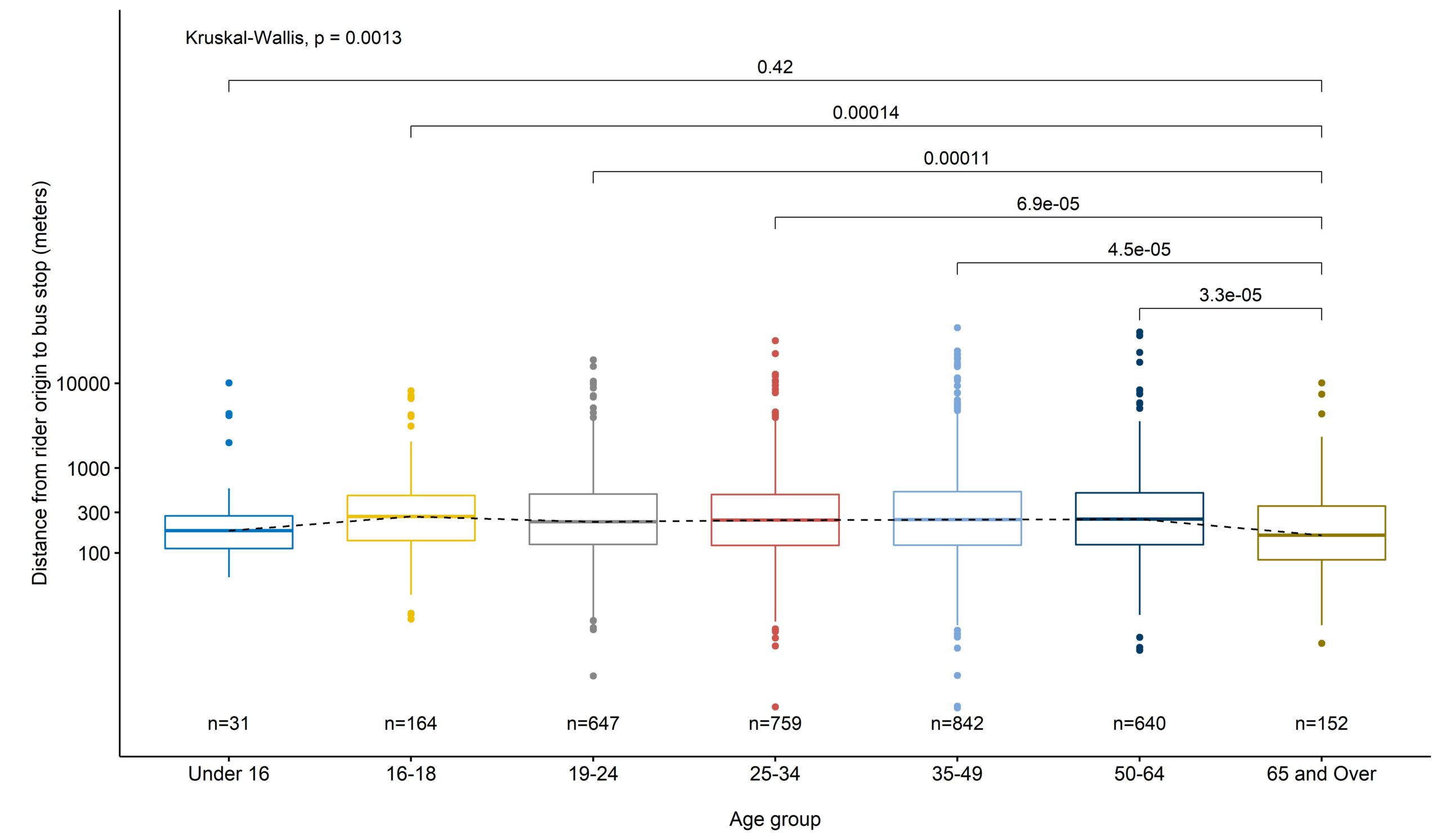Limitations and opportunities with public transit for an aging population in Central Indiana
Many older adults in Central Indiana rely on public transit to maintain their independence. However, transit options are often not well-known nor easily accessible. This State of Aging in Central Indiana Report (SoAR) research brief addresses important aspects of public transit accessibility for older adults in Central Indiana.
- Older adults travel a shorter distance to a bus stop than any other age group in Marion County. On average, adults age 65 and older travel one-tenth of a mile to reach a bus stop. Other adults (age 16 or older) travel an average of 24-38 percent farther to reach a bus stop.
- Three quarters of older IndyGo riders travel less than a quarter mile to a bus stop. Only about one-third of older adults in Marion County live that close to a bus stop.
- Rural and urban demand transit are the most inefficient means of transit in Indiana in terms of transit financial expenditures per rider, but these are often needed for older adults. To efficiently improve transit access where older adults live, a combination of planned housing and coordinated regional transit development is needed.
Introduction
Within Central Indiana, public transit access is critical for many older adults to participate in essential activities such as shopping, health trips, and social activities.1In fact, greater access to public transit for older adults may decrease prevalence of depression2, particularly because better transit access can alleviate social isolation in older adults.3However, public transit access in rural areas is commonly worse than that in urban areas. Furthermore, rural areas oftentimes have greater proportions of both older and sicker populations—partly due to trends such as younger adult out-migration, cost of living disparities, and rural areas being more desirable for retirement.4Marion County Urban Transit
Older adults and children tend to travel the shortest distance to a bus stop
Median distance in feet traveled to bus stop by age groupOn average, it’s farther to bus stops in the outskirts of Marion County.
Median distance from the center of each census tract to the closest bus stopThere are more older adults in suburban Marion Co. who are likely too far from a bus stop to easily use.
Older adult population living farther than a fifth of a mile from a bus stop.Detailed data look:
Distance from rider origin to initial bus stop by age group
(Click the image to enlarge it.)Access to grocery stores is greatest along IndyGo routes.
Number of grocery stores reachable from the center of each tract in 30 minutes on transit Leaving at 8 a.m. Monday, including wait time for busAccess to places of worship is greater than any other target destination.
Number of places of worship reachable from the center of each tract in 30 minutes on transit. Note that individuals are likely to be more selective about places of worship they would actually attend. Leaving at 8 a.m. Monday, including wait time for busTravel to health clinics is easiest in downtown Indianapolis.
Number of clinics reachable from the center of each tract in 30 minutes on transit Leaving at 8 a.m. Monday, including wait time for busTransportation outside of Marion County
The new CICOA 2022-2023 Aging & In-Home Solutions guide is also now available, which contains information on several Central Indiana transit options for older adults.
Example of barriers and challenges for older adults with transit in outlying counties of Central Indiana
Demand-response trips, the kind of public transit that is available in rural and suburban counties, can be complicated to navigate. The fares vary between systems and for different types of riders. Advance scheduling requirements vary from same-day to a week or more ahead of a trip. And different counties' systems do not connect well. These hypothetical example trips illustrate the challenges of navigating rural and suburban transit.
Walk to Johnson County Courthouse 10 minutes
Take Franklin West bus to Walmart Access Johnson County Zip Line $1.00 - 21 minutes
Take Zip North bus to Greenwood Park Mall Access Johnson County Zip Line Free transfer - 45 minutes
Take Route 31 to Transit Center IndyGo $1.75 - 59 minutes
Take Route 37 to Eskanazi IndyGo Free transfer - 13 minutes
One-way cost: $2.75 One-way time: 3 hr 15 min
This trip is affordable but takes a very long time. Solutions might include regional rapid transit or subsidized ride-sharing.

Call to reserve trip Boone County Senior Services 1-2 week ahead
Take ride from home to Walmart Boone Area Transit System Suggested donation - 20 minutes
One-way cost: Donation only One-way time: 20 min
This trip is affordable and fast but requires a reservation 1-2 weeks ahead of time. This is useful for planned errands, like groceries, but not for last-minute needs. Solutions might include subsidized ride-sharing.

No service available Morgan County Connect ends service at 5 pm.
Cannot complete trip
This trip cannot be completed because the demand response service in Morgan County ends at 5 pm. Solutions include extended hours for demand response, a carpool, or subsidized ride-sharing.
Assessing transit needs in outlying Central Indiana counties

Cross-county travel limitations in Central Indiana
Costs per rider for agencies is high for on-demand transit services.
Often these are the only services available for rural or suburban residents.But cost per mile is more similar across transit types.
Suburban and rural transit systems travel farther per rider.- One quarter are interested in moving in the next few years
- Four in ten say sidewalks and cultural amenities are important in the place they choose to live
- One quarter desire shops and restaurants within walking distance
- One-fifth want to live in a place with available public transit
- SAVI Community Trends, “Who rides the bus: Examining transit ridership in Marion County,” Fall 2017 https://viewer.joomag.com/who-rides-the-bus-examining-transit-ridership-in-marion-county-who-rides-the-bus/0799123001505320723?short
- Yang, Y., Langellier, B. A., Stankov, I., Purtle, J., Nelson, K. L., & Diez Roux, A. V. (2019). Examining the possible impact of daily transport on depression among older adults using an agent-based model. Aging & mental health, 23(6), 743-751.
- Lamanna, M., Klinger, C. A., Liu, A., & Mirza, R. M. (2020). The association between public transportation and social isolation in older adults: A scoping review of the literature. Canadian journal on aging/La Revue canadienne du vieillissement, 39(3), 393-405.
- Jensen, L., Monnat, S. M., Green, J. J., Hunter, L. M., & Sliwinski, M. J. (2020). Rural population health and aging: toward a multilevel and multidimensional research agenda for the 2020s. American Journal of Public Health, 110(9), 1328-1331.
- The actual 75th percentile of data is 358 meters, or 1174.5 feet.
- No statistically significant difference (p < 0.05) found. For box plots generated in this report, the grouped nonparametric Kruskal-Wallis p-value represents the likelihood that all age groups are statistically the same, and paired two-sample nonparametric Wilcoxon rank sum tests (Mann Whitney test) represent the likelihood that both groups are from the same population.
- It is noted that the overall sample size (n = 152) becomes reduced to much smaller numbers when subgrouping by 5 different races/ethnicities for adults age 65 and over.
- There are slight negative correlations between older adult (age 65+) population in census tracts and the amount of grocery stores, health clinics, and places of worship within 30-minute access. However, this 30-minute access estimation makes assumptions about walking time and mobility that may not hold true for many members of the older adult population.
- Here, the box and whisker plots display distance (in meters) from an IndyGo riders' point of origin to their initial bus stop, grouped by age. We display meters here instead of feet or miles like in the rest of the research brief. Meters are the conventional way to report data for comparison internationally in the peer-reviewed literature, and are how these values were originally calculated through programming equations. One meter is approximately 3.3 feet, and 1609 meters are in a mile. The y-axis is log10 transformed, to normalize appearance of the data and make it fit on one axis. Distance is geodesic, meaning it is point-to-point shortest distance along a path, but takes into account curvature of the earth. The horizontal line within the boxes represents the median. The whiskers represent the range in which the middle 50% of riders fall. The p-values at the top of the figure indicate if the age groups are likely to truly be different from one another, or if differences occur just because of random variation. Differences in distance to the bus stop are statistically significant (p < 0.05) between older adults and all other age groups except children. The letter "n" represents the number of samples in each age group.

